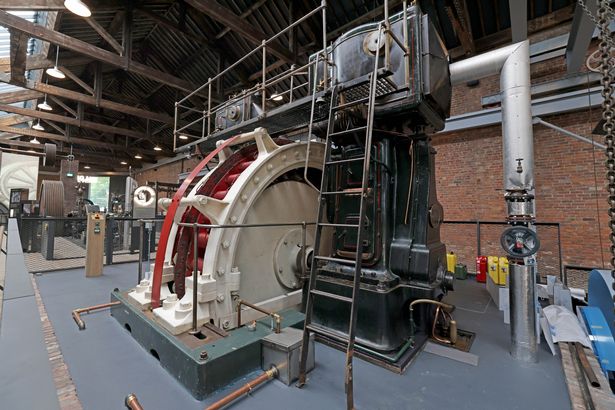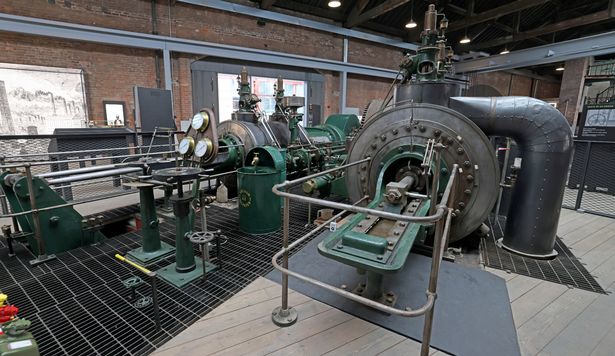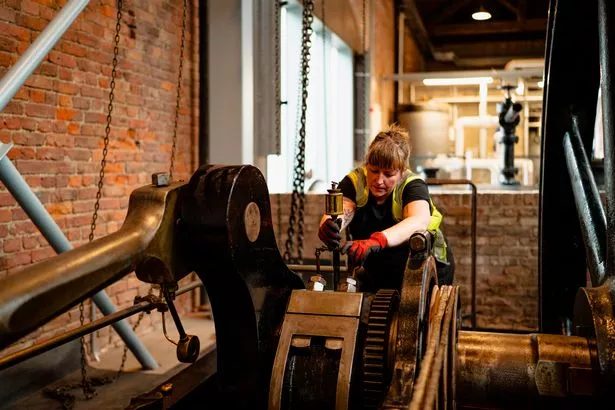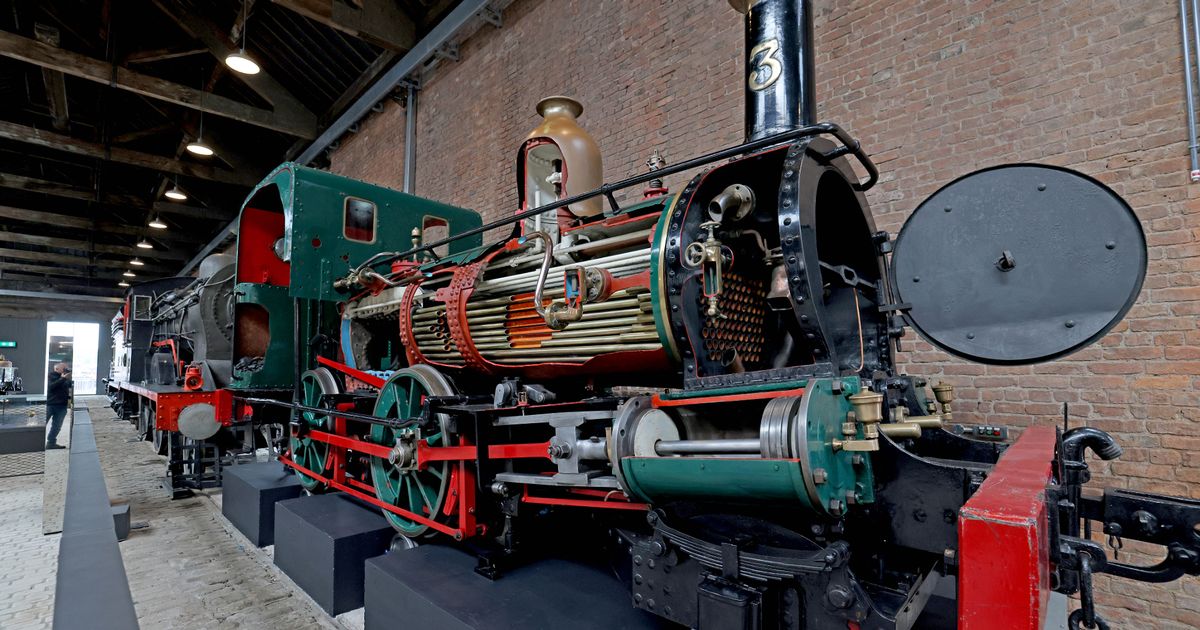Visitors will be able to explore working steam engines, some of which are running for the first time in almost a decade The Science and Industry Museum’s Power Hall has reopened (Image: Jason Roberts /Manchester Evening News)
The Science and Industry Museum’s Power Hall has reopened (Image: Jason Roberts /Manchester Evening News)
For certain generations growing up in Greater Manchester meant a visit to the Science and Industry – a multisensory experience that usually involved exploring the museum’s iconic Power Hall.
A memory at the forefront of many people’s minds will be that unmistakable smell of the oil used to fuel the historical working engines within the former shipping shed of the historic Liverpool Road Station – the world’s first inner-city steam powered passenger railway.
The clank of whir of the engines, hypnotic motion of a piston and that unmistakable hiss of the steam have made it one of the most immersive exhibitions in the city.
In 1983, the Power Hall opened to the public for the first time, and was the first and one of the best-loved galleries in the museum boasting the UK’s largest collection of historic working engines.
Stay connected with our City Life newsletter here
Home to a stunning collection of working engines, it has rightfully become a Manchester institution, an important window into the city’s past engineering feats and reputation as a hub of industry.
In 2019, after delighting generations for nearly 40 years, the doors of this grand building were closed due to a number of structural issues.
 The Power Hall roof during renovation (Image: www.jasonlock.co.uk)
The Power Hall roof during renovation (Image: www.jasonlock.co.uk)
But in just a couple of weeks time, they’ll be reopened after an epic repair and restoration process, including a pioneering de-carbonisation project to reduce the buildings carbon emissions.
Soon, its gleaming engines, refreshed displays and greener technology powering the steam engines and warming the building will be ready for the public to enjoy once again.
“This was the first big gallery to open when the museum first opened in 1983 and it’s got a real place in everyone’s hearts, so having to close it was very hard, but we really did need to do it because it required a lot of work, explained Sally MacDonald, Director of the Science and Industry Museum.
“What people will notice inside is that we’ve renewed all the interpretation because we wanted to tell people’s stories and the stories of the people who worked with these engines and kept them running over many decades.
“The most exciting thing is that we’re powering these 19th century engines via a ground source heat pump, so the engines that would have been coalfired are now being powered by green energy.
 Returning visitors will also be pleased to see a replica of the Planet steam locomotive, built by skilled volunteers inside Power Hall in 1992(Image: Jason Roberts /Manchester Evening News)
Returning visitors will also be pleased to see a replica of the Planet steam locomotive, built by skilled volunteers inside Power Hall in 1992(Image: Jason Roberts /Manchester Evening News)
“We’re stood inside what was the shipping site, so any goods that came into this site would have been loaded into wagons and off into the city, and same in reverse for export, so it’s a very important building, so we needed to respect that with the new interpretation what the building was.”
Taking a sneak peek inside the Grade II-listed building, we were able to step back inside and rediscover engines that powered everything from cotton mills to chip shops, electricity generators to railways.
The new roof (the length of a premier league football pitch) re-used most of the original slates, laid over sustainable wood-fibre roof installation, while original features were improved and repaired to make sure sustainability was always at the forefront.
Other works complete include repairs to timber trusses, conservation of historic brickwork, new insulated roof lights, windows and doors, expanded guttering to manage increased rainfall, the installation of a new electric boiler powered by a vast new water source heat network to power its display of engines, and new LED lighting ensure the building is weather resistant and sustainable.
As part of a sector-leading programme of de-carbonisation, which places zero carbon technologies at the heart of the visitor experience, the museum has used the natural resource of water from an underground aquifer to heat its buildings, a renewable resource which was first used to power the Industrial Revolution from this site in the early 19th century and is now being used to power a green revolution.
 As part of the exhibition’s new narrative, there will also be a wealth of new stories on display that focus on the people who have powered our lives both past and present.(Image: Jason Roberts /Manchester Evening News)
As part of the exhibition’s new narrative, there will also be a wealth of new stories on display that focus on the people who have powered our lives both past and present.(Image: Jason Roberts /Manchester Evening News)
As you enter the 2,500 square metre space through a new central entrance with better access, one of the first exhibits you will spot is the Pender, a steam locomotive used to transport holiday makers around the Isle of White in the 1870s, with a cut away side and digital screen allowing you to see what it is like in the main cabin.
Returning visitors will also be pleased to see a replica of the Planet steam locomotive, built by skilled volunteers inside Power Hall in 1992.
The original pulled passengers between Liverpool and Manchester from 1830 to 1840 and was the next iteration of steam locomotive after Stephenson’s famous prototype, Rocket.
“One of the key things is our beautiful, working historic engine collection,” adds Sarah Baines, the museum’s Curator of Engineering.
“It’s a globally significant collection of working engines made in Greater Manchester, so there’s engines made from right across the region – from Salford, Manchester and Gorton, to Openshaw, Bury, Oldham and Rochdale – it really represents the industrial revolution in this area and how the world was transformed by workers here in Manchester.”
 The Power Hall Restoration at the Science & Industry Museum(Image: Science Museum Group)
The Power Hall Restoration at the Science & Industry Museum(Image: Science Museum Group)
The Durn Mill steam engine will also be up and running, which was originally used to power weaving machinery at an 1800s mill near Rochdale.
To enhance the experience, circulation and sightlines have also been clarified by reinstating the historic central platform and goods shed layout, transporting visitors back hundreds of years.
As part of the exhibition’s new narrative, there will also be a wealth of new stories on display that focus on the people who have powered our lives both past and present.
From the first women to have a full career as an electrical engineer, and a woman forced to pick cotton on American plantations that was supplied to Manchester’s mills, to present-day designer of wind turbines, and the control systems engineer who uses ‘digital twins’ to improve real-world industrial processes, it will tell the story of those who have shaped our city’s relationship with energy and engineering.
Brand new interactive displays will also get visitors’ cogs turning as they build, pump, hammer and even crawl their way through a number of hands-on activities aimed at putting problem solving skills to the test.
 Seeking to inspire the next generation of engineers, the Power Hall also shows engineering in action.(Image: Jason Roberts /Manchester Evening News)
Seeking to inspire the next generation of engineers, the Power Hall also shows engineering in action.(Image: Jason Roberts /Manchester Evening News)
Seeking to inspire the next generation of engineers, the Power Hall also shows engineering in action.
Live demonstrations of the working engines will showcase the skills of the museum’s expert team of technicians, explainers, conservationists and intergenerational volunteers, alongside budding engineers on T-level placements, who are working to preserve Manchester’s heritage by ensuring past skills endure and future technical skills and careers develop.
“When we’re doing the daily demonstrations of the buildings, we’ll have our fabulous explainer team in here, but visitors will also be able to see engines worked on by technicians and we have volunteers, T-level students and appendices, so it’s very much about how do we keep these engineering skills alive,” added Sally.
Meanwhile, Stephen Hoyle, the museum’s Technical Services Manager oversees the team, and is excited for the opportunity to show visitors about the importance of engineering careers for the future.
“In the pandemic we lost a lot of skills so regenerating a team of technicians that can comfortably look after these machines is a challenge,” he reflected.
 (Image: Science Museum Group)
(Image: Science Museum Group)
“We’ve always had to have one foot in the past and one foot in the future, so we’ve created a whole eco-system with T-Level placements with Manchester College, a wraparound volunteering programme and then training the technicians themselves.
“We want to be inspiring the next generation of technicians and engineers. And we have the responsibility of passing down the baton.
“It’s a massive challenge and priority for the city to keep technical skills on the agenda because it’s fallen away over the last 20 to 30 years due to the move towards digital at all costs, so this is a rebalancing and inspiring people.”
The Power Hall: The Andrew Law Gallery will reopen once again on Friday, October 12. Visits to The Power Hall are free and included as part of a free museum ticket.
